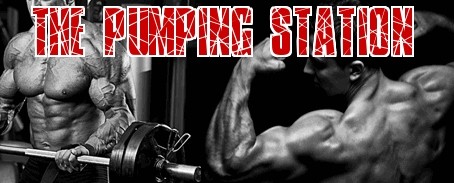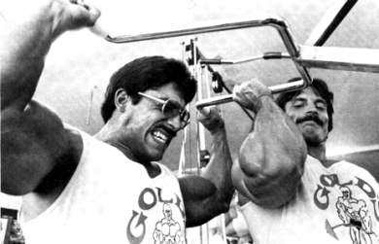The Phenomenon of Indirect Effect
Ray and Mike Mentzer Trained with High Intensity
By Steve Wedan (visit his website at www.SteveWedanArt.com)
Many years ago, the entire bodybuilding world watched Mike Mentzer grow very large. With each contest, his proportions swelled, and fans stated at every "heavy duty" photograph they could find in the magazines.
Likewise, some of us even recall the few pictures published of a 19-year-old Mentzer in York the year Casey Viator won the AAU Mr. America. There was talk of the unusual arms on the boy (Mentzer) as good, some said as Viator's arms. A few years later, a significantly more muscular Mentzer emerged in the IFBB and began an incredible career, climbing the ladder of national and international physique titles, growing gigantic in the process.
An erudite man, Mentzer recorded his training thoughts in journals not normally given to science, publicly crediting his improvement in 1976 to an increase in training intensity. And when an almost unbelievably muscular Mentzer materialized in 1979, once again it was due to another application of increased intensity.
Make no mistake here. Mentzer is a man of enormous natural talent...potential no less notable than other bodybuilders who know little of high intensity. But his well-documented progress is nonetheless directly attributable to his well-organized increase in intensity and the attendant diminishing of exercise volume. Harder, briefer exercise helped create larger, stronger muscles.
However, a number of trainees seem to suffer overtraining even from such brief workouts once they genuinely achieve an intense level of effort. A major reason, I believe, is either ignorance, or a neglecting, of the principle of "indirect effect". Exploiting indirect effect can become the key to excellent, even startling, gains.
Indirect effect can be thought of as a sort of ripple effect. The exact physiological processes aren't completely clear, but what happens on a muscle-training level is clear. Put simply, when you work one muscle, other unworked muscles are affected; when it grows, they grow...to a smaller extent, of course. How much of an effect an unexercised muscle receives from an exercised muscle depends mainly on two things - the size of the worked muscle and its proximity to the unworked muscle.
Take the hips and thighs as an example. One reason the squat is considered such a great overall exercise is the sheer volume of muscle the movement exercises. It's part of bodybuilding legend how the squat affects overall body strength and size. This effect is only partially due to metabolic stimulus.
Much of the credit goes to its nature as a big, three-joint exercise (hips, knees and ankles are all involved). Of course, the lower back is also stimulated because it is involved in the move. But trainees have found overall strength and size increases as a result of squatting - even when it is the only exercise performed for long periods. Here we have a sound explanation for recommending multiple joint exercises for bodybuilders seeking muscle size increases.
Naturally, isolation is an important component for stimulating muscle growth, and exercises that work large muscle areas don't have to be compound movements. The pullover done on a Nautilus machine is an example of an exercise that works a very large volume of muscle without being a compound movement. For this discussion, though, I'm considering conventional equipment which restricts most large-muscle moves to multijoint exercises.
When an intermediate or advanced bodybuilder finds himself on a plateau, he is wise to consider cutting back on workout volume, while reasserting his commitment to a high intensity of effort. But the arithmetic of bodybuilding soon presents a difficult problem, If he needs, say, 20 exercises to work everything, and he's decided to cut back to 16 total sets of high intensity work in order to keep gaining, how does he cover all bases? Does he start splitting his workouts? What would a split routine do for his calves, abs and arms, which he feels need three workouts in a week?
Here is where indirect effect comes in. When a bodybuilder nears the advanced level, he's beginning to get pretty strong. The stronger he is, the more a set of exercise can make an inroad into his existing abilities. So a quality, set of curls ought to take longer to recover from that is used to, 20 muscular pounds and an inch of size ago. Likewise, the indirect effect ought to be greater as well. So we use the body's abilities to create inroads into existing strength to our advantage.
Look at the workout accompanying this article for a few minutes. The very first things a musclehead will notice is that upper arms are exercised only once during the three workouts. Egad! This crazy author thinks I want spaghetti arms! Doesn't he realize I plan to win Mr. America next year looking like Larry Scott? I'd better leave this nut to the pipestem, get-in-shape, "muscle tone" crowd...
Well, before you click to another article, let me say that this routine isn't hypothetical. It works. Assuming you understand the meaning of deep commitment and very hard work, that routine will guide you to significant gains. So read on.
Workouts one and three are the ones that stress your largest muscle masses in the upper and lower body, with the first emphasizing the legs, while the torso is hammered in the third. A careful look will reveal that your arms are actually worked hard on all three days, even though it's not always direct isolation. Actual experience on this routine will reveal a growth-indicating pump in the upper arms and forearms every workout. And what growth isn't created by direct arm work is induced by the indirect effect of torso work. Similar things can be said of delts, calves and abs based on the same principle.
This can be carried to a logical extreme. Mike Mentzer's brother, Ray, put three-eights on an inch on his presumably larger upper arm in six weeks, performing no more direct arm work that chins and dips. Remember, this was on an advanced bodybuilder, the hardest specimen to realize real muscle growth because of being so close to his genetic potential. And his size increase is all the more impressive for having been accomplished while getting leaner.
A similar result occurred when Arthur Jones put Ray on an eight-exercise, one-set-to-failure (drop sets being considered one set) exercise program in 1983. If any nontheoretical, real-life example will serve to prove the efficacy of indirect effect. Ray Mentzer's experience is it. You can make it work for you.
It's easy to drift away from high intensity principles. As bodybuilders most of us want to feel as though we're "sculpting our bodies" not allowing nature (read: rest) to do most of the job for us. We read the sarcastic and bitter attacks of strength coaches and naturally gifted weightmen who try to tell us that everyone knows that one-set-to-failure is an exercise philosophy that never really worked. And yet, Ellington Darden, Ken Leistner and Peary Rader have watched hundreds of men and women gain real muscle that was impossible for them to build before training harder and briefer.
And although their lights have faded, Ray and Mike Mentzer built some of the biggest muscles the world has ever seen using these methods. Don't let'em food you. Life is too short to be small. Try this routine and let the detractors claim you do 'roids, sneak in extra sets after the gym closes or you're naturally muscular. And laugh all the way to the big-shirt store!
The Workout
Day One
Leg Press
Leg Extension
Squat
Rest 3 to 5 minutes
Leg Curl ...Breakdown (one drop in weight)
Calf Raise... Breakdown (two drops)
Rest 2 minutes
Chin
Dip
Crunch...Breakdown (one drop in weight)
Rest 2 minutes
Stiff-legged Deadlift
Wrist CurlDay Two
Calf Raise...1 1/4 reps
Rest 2 minutes
Barbell Curl...Stage reps
Chin
Rest 1 minute
Triceps Extension...Super-slow
Dip
Rest 2 minutes
Wrist curl...1 1/4 reps
Reverse curl...Stage reps
Wrist rollerDay Three
Squat
Rest 2 to 3 minutes
Dumbell Flye
Bench Press
Incline Flye
Dip
Rest 2 to 3 minutes
Pullover
Undergrip row
Pullover
Pulldown Behind Neck
Rest 2 to 3 minutes
Lateral Raise
Press Behind Neck...Stage reps
Shrug
Upright Row
Press Behind NeckNotes
Work out no more than three days per week. Make them alternate days, and try to rest on your off days.
Perform the exercises in this routine back-to-back, except where a rest is indicated. If you have not developed the metabolic conditioning to follow these routines, then back off. You can build up to it.
To see High Intensity workouts in action watch the Mike Mentzer training video.
Definitions
Breakdowns - This practice involves stripping off about 10% of the resistance you're using and grinding out a few more reps. You can opt to drop the poundage once or twice a week, depending on how much intensity you're ready for. Start your reps immediately with each breakdown; don't spend an extra moment as a breather. If you can press two partners into service, there will be hardly a break in your breakdowns, make this a very advanced principle.
Stage Reps - Here you have a way in which to work around both the sticking points in an exercise and the lockout. Divide the movement into thirds. Then, perform slowly paced reps in the hardest one-third (or stage), first; the second hardest, next; and the easiest thirst, last. In a relative sense, the so-called easiest stage will not seem at all easy. Get ready for an incredible pump.
1 1/4 Reps - After bringing the bar into a contracted position, let it return only one-quarter of the way, then contract it again. Only then do you let it return to full extension.
Super-Slow - Take a full 10 seconds to perform the positive part of the reps and four seconds for the negative. This is a great way to isolate a muscle that tends to miss it due to less-than-perfect form. Reduce your resistance 30% and your reps about half of normal.
If you have any questions about Mike Mentzer or High Intensity Training email us and we'll get back to you with an answer as quick as we can.
Click Here to Sign Up for Your Free Bodybuilding Magazine Subscription

